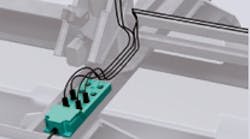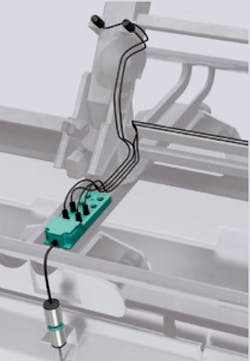Many sensors need to send power and control signals through barriers, between stationary and movable equipment, and over rotating or exchangeable machine sections.
Consider a conveyor that moves parts through an assembly plant. One common setup is to have trays (called carriers) on the conveyor containing parts needing work at various plant stations. When the conveyor parks a part-filled carrier at a given station, a robot jumps into action and performs a task on the parts. But first, controls must verify the parts are positioned properly. For this job, engineers often fix sensors to the carriers that send position confirmations to the controls.
It’s common for engineers to use mechanical connections such as slip rings, high-flex cabling, and high-density connectors to get power and signals to and from these kinds of traveling sensors. But these options have drawbacks. Sometimes they don’t fit into a machine’s geometry. Plus many slip rings are prone to contact wear. Cables tend to flex and snag. High-density connections are costly and possible sources for contact failure.
Inductive coupling is a more versatile option for transmitting power and signals between mobile sensors and stationary controls.
Inductive coupling is noncontact electromagnetic transmission that uses current flow through coils of wires on one side of the setup to induce voltage in coils of wires on the other side of the setup. In this way, this transmission lets machine controls wirelessly transfer primary-system side power and signals to exchangeable or movable secondary sides. Inductive coupling also lets users leverage all the benefits of wireless signal transfer by reducing wiring for maintenance-free, cost-effective connections.
To make inductive coupling an option for sensors, some manufacturers offer exchangeable cartridges with two transmitters that pass electrical signals across an air gap — usually to the control-system auxiliary or main control panel.
Inductive couplings can make single or multisensor connections across air gaps.
Two caveats: Inductive coupling makes for simple power and signal transfer without using batteries, but transmission elements must be within 20 mm of one another. In addition, the elements must be stationary when signals go from the secondary element to the primary.
Pepperl+Fuchs provided information for this column.


